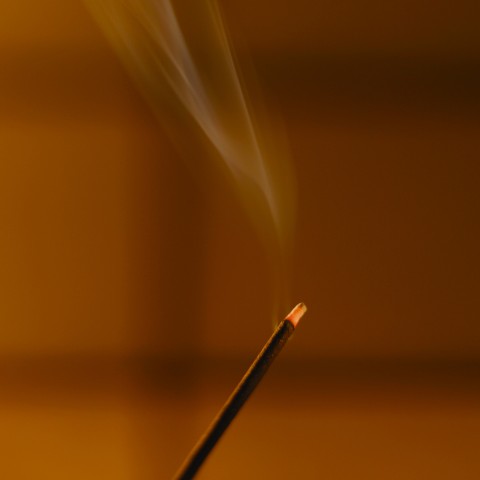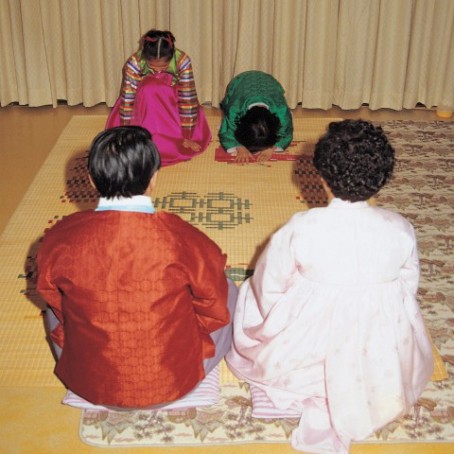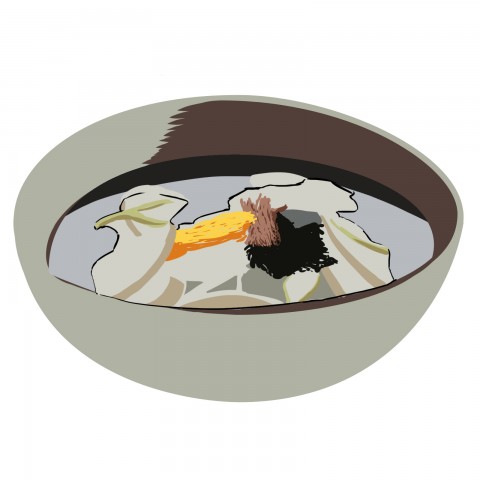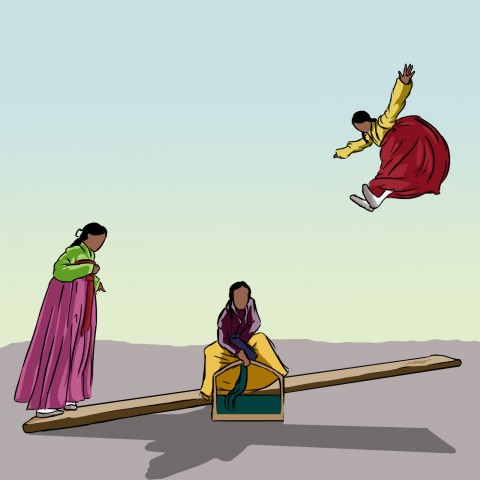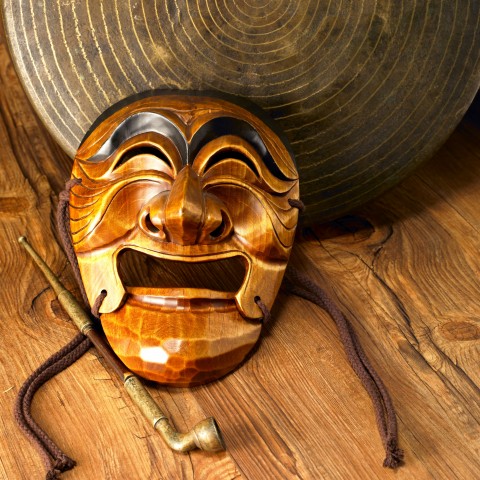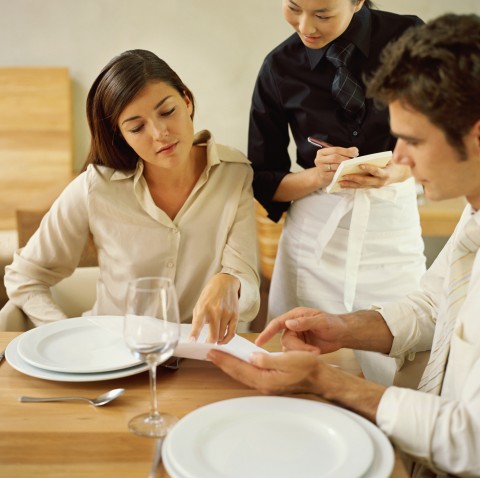On the Lunar New Year, or Seollal, Koreans celebrate one of the country’s most important holidays. The Lunar New Year celebration in South Korea focuses on respect for one’s elders and ancestors, as well as time with family and loved ones.
In this blog post, we will focus on the importance of Seollal and the festivities that native Koreans enjoy during this important holiday.
At KoreanClass101.com, it’s our aim to make every aspect of your language-learning journey both fun and informative—starting with this article! Let’s get started.
Table of Contents
- 설날 (Seollal) and Its Importance in Korea
- Paying Tribute to Ancestors During 설날 (seollal)
- 세배 (sebae), the New Year Bowing
- 떡국 (tteokguk) and other Korean Traditional Dishes
- Traditional Games
- Essential Korean Vocabulary for the Lunar New Year
- Final Thoughts
1. 설날(Seollal) and Its Importance in Korea
설날 (seollal), the ”Lunar New Year Holiday,” is one of the most important holidays for native Koreans (the other one is Chuseok). It is a time when nearly everyone heads back to their 고향 (gohyang, hometown) to visit their 부모님 (bumonim, parents) and 친척 (chincheok, relatives) to celebrate the New Year, enjoy food, and to hold memorial ceremonies for their ancestors.
This means that tourists planning to visit Korea at the beginning of a new year need to check every year to see which day 설날 (seollal, Lunar New Year’s Day) falls upon, as it is different from the New Year that western countries celebrate. In actuality, native Koreans take time off twice to celebrate the New Year Holidays!
The first celebration takes place on January 1st every year as it does in western countries – native Koreans call this holiday 신정 (sinjeong), or the “Solar New Year Holiday”. 설날 (seollal), or 구정 (gujeong), the ”Lunar New Year Holiday”, is a bit trickier – as the actual date of celebration changes every year. This means you will sometimes see people take time off in January, and sometimes in February. Why is this?
This is because 구정 (gujeong) goes by the 음력 달력 (eumnyeok dallyeok), or “Lunar Calendar”.
So if you want to check which day 설날 (seollal), or 구정 (gujeong) lands on, you could ask:
올해 구정은 언제입니까?
Olhae gujeongeun eonjeimnikka?
“When is the Lunar New Year’s Day this year?”
Or
올해 설날은 언제예요?
Olhae seollareun eonjeyeyo?
“When is the Lunar New Year’s Day this year?”
Here’s a list of upcoming 설날 (seollal) dates from 2019 to 2028:
- 2020 – January 25
- 2021 – February 12
- 2022 – February 1
- 2023 – January 22
- 2024 – February 10
- 2025 – January 29
- 2026 – February 17
- 2027 – February 7
- 2028 – January 27
- 2029 – February 13
While 설날(seollal) is actually just a day, most native Koreans brave hours on the road to visit their 부모님(bumonim)=”parents” and their 고향 (gohyang)=”hometown”, so the government designates approximately 3 days as public holidays. If the last day of the holidays is a 금요일 (geumyoil)=”Friday” or the beginning of the holidays is a 월요일 (woryoil)=”Monday”, you can consider the connecting 주말 (jumal)=”weekend” as a part of the holidays and plan your trip accordingly.
Celebrating Seollal in Korea means a trip to see family. Because Koreans leave for their hometown to visit family before the Lunar New Year, traffic often becomes a real problem for travelers. Most people will plan their visits strategically as the 귀경길 (gwigyeongkkil, the road/trip home) may take hours and you may find yourself stuck in traffic. So some people book 기차표 (gichapyo, train tickets) and 비행기표 (bihaenggipyo, airplane tickets) months in advance to avoid the traffic congestion. However, for those in the big cities, the opposite may be true—it’s not uncommon for businesses to close and larger cities to become empty. In some cases, Koreans no longer living in Korea may take an “oversea trip,” or 해외여행 (haeoeyeohaeng), to see their family.
Of course, in recent times, some people use this holiday period to go overseas, but most native Koreans will endure the long hours on the road for time with their family.
Traditional Korean clothing for this day is called 한복 (hanbok). Considering the colorful nature of Korean culture, it should come as no surprise that the hanbok is often bright and bold, in colors such as yellow, green, and red. However, due to the difficulty and time involved in actually putting on this traditional garb, many people forego it altogether—oftentimes, only children are forced to wear the hanbok.
2. Paying Tribute to Ancestors During 설날(seollal)
On the Lunar New Year, South Koreans often visit the graves of their ancestors, especially those of their late 할머니 (halmeoni), or “grandmother,” and 할아버지 (harabeoji), or “grandfather.” This is done to show respect to them. Another one of the reasons why native Koreans head back to their hometowns to meet with their parents and relatives is to get together to pay tribute to their ancestors through a ceremony called 차례 (charye), or 제사 (jesa), which means ”a memorial ceremony for ancestors”.
Some Koreans perform another ceremony in honor of their ancestors. This ceremony involves preparing a 구정 음식 (gujeong eumsik), or “New Year’s meal,” for which family members will prepare various dishes to be placed on a low table, including fish, meat, rice, fruit and other dishes and alcohol that the deceased ancestors liked. Once the table has been set, family members will light 향 (hyang, incense), then 절하다 (jeolhada, bow) to the ancestors to show respect. They will also stick chopsticks straight up into the 밥그릇 (bapgeureut, bowl of rice) and ask the spirits of the ancestors to visit and enjoy the food prepared by the living members of the household.
This is why after the holidays are over, you may overhear native Koreans having a conversation such as:
A: 설날에 뭐했어요?
Seollare mwohaesseoyo?
“What did you do during ‘seollal’?”
B: 가족도 만나고 제사도 드렸어요.
Gajokdo mannago jesado deuryeosseoyo.
“I met my family and we had a memorial ceremony for our ancestors.”
3. 세배 (sebae), the New Year Bowing
세배 (sebae, bowing) is a very important part of the Lunar New Year holiday. 세배 (sebae) is kneeling on the ground and bowing one’s head to the floor. Usually, younger people will bow to members of the family that are older and wish them a happy new year by saying:
새해 복 많이 받으세요.
Saehae bok mani badeuseyo.
“Wishing that you receive a lot of luck in the new year.”
In return, the family members on the receiving side prepare 세벳돈 (sebetdon, money in return for receiving a bow). As this act is done for someone older/senior, people will describe it using the verb 드리다 (deurida), which is the honorific form of the verb “give”. Those with more family members tend to get more cash in their Seollal gifts!
For example, to say the following:
할머니께 세배 드렸어요.
halmeonikke sebae deuryeosseoyo.
“I bowed to my grandmother.”
would mean ‘I did the sebae bow’. When bowing, you can say 새해 복 많이 받으세요 (sehae bok mani badeuseyo), which means ‘Have lots of luck in the new year’.
4. 떡국 (tteokguk) and other Korean Traditional Dishes
One traditional dish that every native Korean will eat during the 설날 (seollal) holidays is 떡국 (tteokguk, rice cake soup). The base of the soup differs depending on the province, but most families will prepare a bone marrow soup and add sliced rice cakes, egg, and chopped spring onions. The reason why native Koreans eat this dish is because people believe that in order to become a year older, you need to eat a bowl of this rice cake soup. Some people jokingly state after they’ve cleared two bowls of 떡국 (tteokguk) that they have aged not one, but two years as they finished two bowls instead of one!
Another dish you will see is 전 (jeon, fried pancakes). This is not actually a pancake, but various ingredients such as meat or fish, or sometimes vegetables, which are rolled in flour and dipped in raw beaten egg before being fried. It takes time to prepare, but is very delicious and commonly found in every household during the 설날 (seollal) holidays.
5. Traditional Games
Once family members gather, there is only so much to talk about. So everyone gathers around to play various traditional games.
The most commonly played game is 윷놀이 (yutnori), a traditional Korean board game. It is a very simple game–there are four wooden sticks, which are rounded on one side and flat on the other. You split into two teams, with each member represented by a ‘piece’ you move around the board. Each member throws the sticks and moves their pieces around the board according to how the sticks have landed. All the members of the team need to finish the game before the opposing team in order to win.
Another popular game is 널뛰기 (neolttwigi). It is a traditional outdoor game of Korean women and girls that is typically enjoyed on traditional holidays such as Korean New Year, Chuseok, and Dano. Neolttwigi is similar to seesaw, except that participants stand on each end of the Neol and jump, propelling the person opposite into the air.
Some Koreans also play a popular game called 고스톱 (Go-Stop), which is a game of gambling with cards. Though the cards used are based off of Japanese Hanafuda cards, in Korea they are called 화투, or Hwatu.
6. Essential Korean Vocabulary for the Lunar New Year
Ready to review some of the Korean vocabulary words we covered in this article? Here are the essential words you should know for the Lunar New Year in South Korea!
- 할머니 (halmeoni) — “grandmother”
- 할아버지 (harabeoji) — “grandfather”
- 설날 (Seollal) — “Lunar New Year’s Day”
- 전통 (jeontong) — “tradition”
- 제사 (jesa) — “ancestral rite”
- 친척 (chincheok) — “relative”
- 해외여행 (haeoeyeohaeng) — “oversea trip”
- 세뱃돈 (sebaetdon) — “New Year’s cash gift”
- 새해 (saehae) — “New Year”
- 널뛰기 (neolttwigi) — “Neolttwigi”
- 음력 (eumnyeok) — “lunar calendar”
- 한복 (hanbok) — “hanbok”
- 구정 연휴 (gujeong yeonhyu) — “the Lunar New Year holiday season”
- 구정 음식 (gujeong eumsik) — “New Year’s meal”
- 선물세트 (seonmulseteu) — “gift set”
- 떡국 (tteokguk) — “Ddeokguk”
To hear each of these vocabulary words pronounced, and to read them alongside relevant images, be sure to check out our Korean Lunar New Year vocabulary list!
7. Final Thoughts
We hope you enjoyed learning about the Lunar New Year in South Korea with us. How do you celebrate the new year in your country? Would you like to celebrate Seollal in South Korea after reading this article? Let us know in the comments!
The Seollal holiday is just one example of Korea’s vivid and unique culture. If you’re interested in learning more about Korean culture and the language, you may find the following pages useful:
- All About Korean Culture and Society
- Hangul Proclamation Day: Writing Korean Made Easy
- Secret to Mastering Korean Slang and Abbreviations
- What’s Your Favorite Korean Food?
- Tourist Attractions in South Korea
Korean is a complex language, but learning it doesn’t need to be boring or overwhelming—with KoreanClass101.com, it can even be fun! If you’re serious about mastering the language, create your free lifetime account today.
Happy Korean learning! 🙂



